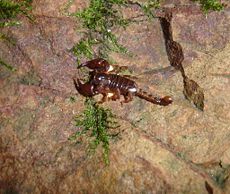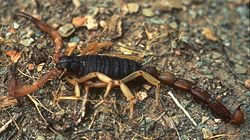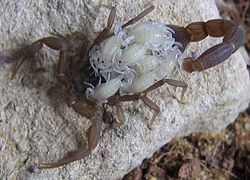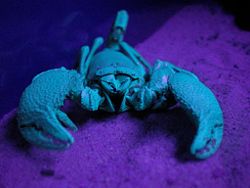Scorpion
| Scorpion | ||||||||||||
|---|---|---|---|---|---|---|---|---|---|---|---|---|
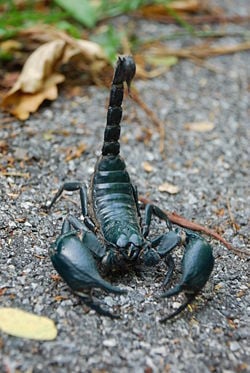 Asian forest scorpion (Heterometrus spinifer) in Khao Yai National Park, Thailand
| ||||||||||||
| Scientific classification | ||||||||||||
| ||||||||||||
|
Pseudochactoidea |
Scorpion is the common name for any of the carnivorous arthropods comprising the order Scorpiones within class Arachnida, characterized by a slender, segmented body with six pairs of appendages, including four pairs of walking legs and one pair of large, claw-like pinchers, as well as a flexible, segmented tail that is curved over the back and has a hollow, venomous sting. There are about 2,000 species of scorpions.
Scorpions are widely distributed south of about 49° N, with the notable exceptions of New Zealand and Antarctica. The northernmost part of the world where scorpions live in the wild is Sheerness on the Isle of Sheppey in the United Kingdom, where a small colony of Euscorpius flavicaudis has been resident since the 1860s (Benton 1991; Rein 2000).
Scorpions are integral to food chains in their terrestrial habitats, consuming various insects and other arthropods, and being consumed by other invertebrates, birds, rodents, and lizards. Their venomous stinger is used to subdue larger prey. For most species, this venom is not dangerous to human beings, although it can be painful. Some species do produce a neurotoxin that can cause convulsions, paralysis, respiratory and cardiac failure, and death.
Scorpions have fascinated human beings for thousands of years, with scorpion-folk depicted in the ancient Epic of Gilgamesh, among the earliest known works of literary fiction, and scorpions associated in Ancient Egypt with the god Set and in Green mythology with the tales of Orion and Perseus. The scorpion is one of the symbols of the astrological sign of Scorpio.
Anatomy
The body of a scorpion is divided into two parts: The cephalothorax (also called the prosoma) and the abdomen (opisthosoma). The abdomen consists of the mesosoma and the metasoma.
Cephalothorax
The cephalothorax, also called the prosoma, is the scorpion's “head,”which is covered by a carapace, and has eyes and six pairs of appendages. These appendages include the chelicerae or mouthparts (short, pincerlike appendages used to tear food for swallowing), pedipalps or claws (large, powerful pincers used to capture prey) and four pairs of walking legs. The scorpion's exoskeleton is thick and durable, providing good protection from predators. Scorpions have two eyes on the top of the head, and usually two to five pairs of eyes along the front corners of the head (Jackman 1999).
Mesosoma
The mesosoma, the front half of the abdomen, is made up of six segments. The first segment contains the sexual organs as well as a pair of vestigial and modified appendages forming a structure called the genital operculum. The second segment bears a pair of featherlike sensory organs known as the pectines. The final four segments each contain a pair of book lungs, which include a hole opening into the body. The mesosoma is armored with chitinous plates, known as tergites on the upper surface and sternites on the lower surface.
Metasoma
The metasoma, the scorpion's tail, comprises six segments. (The first tail segment looks like a last mesosoman segment.) The tal is carried high over the body of the scorpion. The last segment contains the scorpion's anus and bears the telson (the sting). The telson, in turn, consists of the vesicle, which holds a pair of venom glands, and the hypodermic aculeus, the venom-injecting barb.
On rare occasions, scorpions can be born with two metasomata (tails). Two-tailed scorpions are not a different species, merely a genetic abnormality (Prchal).
Geographical distribution and habitat
Scorpions are almost universally distributed south of 49° N, and their geographical distribution shows in many particulars a close and interesting correspondence with that of the mammals, including their entire absence from New Zealand. The facts of their distribution are in keeping with the hypothesis that the order originated in the northern hemisphere and migrated southwards into the southern continent during various epochs, and their absence from countries to the north of the above-mentioned latitudes being due to the comparatively recent glaciation of those areas. When they reached Africa, Madagascar was part of that continent; but their arrival in Australia was subsequent to the separation of New Zealand from the Austro-Malayan area to the north of it.
In the United States, scorpions can be found in 31 different states, including Hawaii (Isometrus maculatus). They are most common in southern Arizona and in a swath of land extending through central Texas and central Oklahoma. The common striped scorpion, Centruroides vittatus, reaches from northwest Mexico to southern Colorado, Kansas, southern Missouri, and Mississippi and Louisiana. Species of the genus Vaejovis are found from Florida north to Maryland, the Carolinas, and Tennessee, and as far west as Oregon and California. Paruroctonus boreus is found through the Northwest United States and into Canada (Southern Saskatchewan, Southern Alberta and the Okanagan Valley of British Columbia).
Five colonies of scorpions (Euscorpius flavicaudis) have established themselves in southern England, having probably arrived with imported fruit from Africa, but the number of colonies could be lower now because of the destruction of their habitats. This scorpion species is small and completely harmless to humans.
Scorpions prefer to live in areas where the temperatures range from 20°C to 37°C (68°F to 99°F), but may survive from freezing temperatures to the desert heat (Hadley 1970; Hoshino et al. 2006). Scorpions of the genus Scorpiops living in high Asian mountains, bothriurid scorpions from Patagonia, and small Euscorpius scorpions from middle Europe can all survive winter temperatures of about -25°C.
The sluggish metabolism of scorpions aids them in surviving in harsh conditions of cold and heat and virtually no food and water; they can survive for more than one year without eating and a slick of wax seals in water (Angier 1990).
Behavior
Scorpions are nocturnal and fossorial, finding shelter during the day in the relative cool of underground holes or undersides of rocks and coming out at night to hunt and feed. Scorpions exhibit photophobic behavior, primarily to evade detection by their predators such as birds, centipedes, lizards, mice, possums, and rats (AM 2003).
Scorpions are opportunistic predators of small arthropods and insects. They use their chelae (pincers) to catch the prey initially. Depending on the toxicity of their venom and size of their claws, they will then either crush the prey or inject it with venom. This will kill or paralyze the prey so the scorpion can eat it. Scorpions have a relatively unique style of eating using chelicerae, small claw-like structures that protrude from the mouth and that are unique to the Chelicerata among arthropods. The chelicerae, which are very sharp, are used to pull small amounts of food off the prey item for digestion. Scorpions can only digest food in a liquid form; any solid matter (fur, exoskeleton, and so on) is disposed of by the scorpion.
Reproduction
Most scorpions reproduce sexually, and most species have male and female individuals. However, some species, such as Hottentotta hottentotta, Hottentotta caboverdensis, Liocheles australasiae, Tityus columbianus, Tityus metuendus, Tityus serrulatus, Tityus stigmurus, Tityus trivittatus, and Tityus urugayensis, reproduce through parthenogenesis, a process in which unfertilized eggs develop into living embryos. Parthenogenic reproduction starts following the scorpion's final molt to maturity and continues thereafter.
Sexual reproduction is accomplished by the transfer of a spermatophore from the male to the female; scorpions possess a complex courtship and mating ritual to effect this transfer. Mating starts with the male and female locating and identifying each other using a mixture of pheromones and vibrational communication; once they have satisfied each other that they are of opposite sex and of the correct species, mating can commence.
The courtship starts with the male grasping the female’s pedipalps with his own; the pair then perform a "dance" called the "promenade à deux." In reality, this is the male leading the female around searching for a suitable place to deposit his spermatophore. The courtship ritual can involve several other behaviors, such as juddering and a cheliceral kiss, in which the male's chelicerae—clawlike mouthparts—grasp the female's in a smaller more intimate version of the male's grasping the female's pedipalps and in some cases injecting a small amount of his venom into her pedipalp or on the edge of her cephalothorax (Hickman et al. 2005), probably as a means of pacifying the female.
When he has identified a suitable location, he deposits the spermatophore and then guides the female over it. This allows the spermatophore to enter her genital opercula, which triggers release of the sperm, thus fertilizing the female. The mating process can take from one to more than twenty-five hours and depends on the ability of the male to find a suitable place to deposit his spermatophore. If mating goes on for too long, the female may eventually lose interest, breaking off the process.
Once the mating is complete, the male and female will separate. The male will generally retreat quickly, most likely to avoid being cannibalized by the female, although sexual cannibalism is infrequent with scorpions.
Unlike the majority of arachnid species, scorpions are viviparous. Even more remarkable, the embryo is nourished internally by the mother's body through a type of maternal-fetal placental connection, such as seen in placental mammals and some sharks (Angier 1990). Gestation can last up to a year and a half, rivaling that of the elephant (Angier 1990).
Life cycle
The young are born one by one, and the brood is carried about on its mother's back until the young have undergone at least one molt. Before the first molt, scorplings cannot survive naturally without the mother, since they depend on her for protection and to regulate their moisture levels. Especially in species which display more advanced sociability (for example, Pandinus spp.), the young/mother association can continue for an extended period of time. The size of the litter depends on the species and environmental factors, and can range from two to over a hundred scorplings. The average litter however, consists of around 8 scorplings (Lourenco 2000).
The young generally resemble their parents. Growth is accomplished by periodic shedding of the exoskeleton (ecdysis). A scorpion's developmental progress is measured in instars (how many molts it has undergone). Scorpions typically require between five and seven molts to reach maturity. Molting is effected by means of a split in the old exoskeleton, which takes place just below the edge of the carapace (at the front of the prosoma). The scorpion then emerges from this split; the pedipalps and legs are first removed from the old exoskeleton, followed eventually by the metasoma. When it emerges, the scorpion’s new exoskeleton is soft, making the scorpion highly vulnerable to attack. The scorpion must constantly stretch while the new exoskeleton hardens to ensure that it can move when the hardening is complete. The process of hardening is called sclerotization. The new exoskeleton does not fluoresce; as sclerotization occurs, the fluorescence gradually returns.
Scorpions have quite variable lifespans and the actual lifespan of most species is not known. The age range appears to be approximately 4 to 25 years (25 years being the maximum reported life span in the species Hadrurus arizonensis).
Venom
All scorpion species possess venom. In general, scorpion venom is described as neurotoxic in nature. One exception to this generalization is Hemiscorpius lepturus which possesses cytotoxic venom. The neurotoxins consist of a variety of small proteins that affect neuronal ion channels responsible for action potentials, which serve to interfere with neurotransmission in the victim. Scorpions use their venom to kill or paralyze their prey so that it can be eaten; in general it is fast-acting, allowing for effective prey capture. The effects of the sting can be severe.
Scorpion venoms are optimized for action upon other arthropods and therefore most scorpions are relatively harmless to humans; stings produce only local effects (such as pain, numbness or swelling). A few scorpion species, however, mostly in the family Buthidae, can be dangerous to humans. Among the most dangerous are Leiurus quinquestriatus, otherwise ominously known as the deathstalker, which has the most potent venom in the family, and members of the genera Parabuthus, Tityus, Centruroides, and especially Androctonus, which also have powerful venom.
The scorpion which is responsible for the most human deaths is Androctonus australis, or the yellow fat-tailed scorpion, of North Africa. The toxicity of the venom of A. australis is roughly half that of L. quinquestriatus, but despite a common misconception A. australis does not inject noticeably more venom into its prey. The higher death count is simply due to its being found more commonly, especially near humans.
Human deaths from scorpion stings normally occur in the young, elderly, or infirm; scorpions are generally unable to deliver enough venom to kill healthy adults. Some people, however, may be allergic to the venom of some species. Depending on the severity of the allergy, the scorpion's sting may cause anaphylaxis and death. A primary symptom of a scorpion sting is numbing at the injection site, sometimes lasting for several days. Scorpions are generally harmless and timid, and only voluntarily use their sting for killing prey, defending themselves, or in territorial disputes with other scorpions. Generally, they will run from danger or remain still.
Scorpions are able to regulate how much venom is injected with each sting using striated muscles in the stinger, the usual amount being between 0.1 and 0.6 milligrams. There is also evidence to suggest that scorpions restrict the use of their venom only to subdue large prey, or prey that struggles.
It has been found that scorpions have two types of venom: A translucent, weaker venom designed to stun only, and an opaque, more potent venom designed to kill heavier threats. This is likely because it is expensive in terms of energy for a scorpion to produce venom, and because it may take several days for a scorpion to replenish its venom supply once it has been exhausted (Cheng et al. 2007; Rein 1993).
There is currently no scorpion equivalent of the Schmidt Sting Pain Index, because nobody has yet classified the levels of pain inflicted by different scorpion stings. This is probably because of the risk involved with some species, such as Androctonus australis or Leiurus quinquestriatus. However, envenomation by a mildly venomous species like Pandinus imperator or Heterometrus spinifer is similar to a bee sting in terms of the pain and swelling that results. A sting on the thumb from a relatively non-dangerous scorpion often feels like the victim has accidentally struck their thumb with a hammer while driving in a nail. A sting on the thumb from a truly dangerous scorpion can feel much worse, as though the victim had hammered a nail right through their thumb. It should be noted that the physical effects of a sting from a medically significant scorpion are not limited to the pain inflicted: There can be bradycardia, tachycardia, or in severe cases pulmonary edema.
The stings of North American scorpions are rarely serious and usually result in pain, minimal swelling, tenderness, and warmth at the sting site. However, the Arizona bark scorpion, Centruroides sculpturatus, which is found in Arizona and New Mexico and on the California side of the Colorado River, has a much more toxic sting. The sting is painful, sometimes causing numbness or tingling in the area around the sting. Serious symptoms are more common in children and include abnormal head, eye, and neck movements; increased saliva production; sweating; and restlessness. Some people develop severe involuntary twitching and jerking of muscles. Breathing difficulties may occur.
The stings of most North American scorpions require no special treatment. Placing an ice cube on the wound reduces pain, as does an ointment containing a combination of an antihistamine, an analgesic, and a corticosteroid. Centruroides stings that result in serious symptoms may require the use of sedatives, such as midazolam, given intravenously. Centruroides antivenin rapidly relieves symptoms, but it may cause a serious allergic reaction or serum sickness. The antivenin is available only in Arizona. In Trinidad, the leaf juice of Eclipta prostrata is used for scorpion stings. Any effect of plants that are used against scorpion stings may be due to symptomatic relief—analgesic, anti-inflammatory, antipruritic effects, in addition to other biological activities. Some compounds from plants used for general inflammation also inhibit enzymes (like phospholipase A2) from snake and scorpion venom. Some of these plant compounds are hypolaetin-8-glucoside and related flavanoids.
Professor Moshe Gueron was one of the first to investigate the cardiovascular effects of a severe scorpion sting. Thousands of stung patients were reviewed. Thirty-four patients with severe scorpion stings were reviewed and pertinent data related to the cardiovascular system, such as hypertension, peripheral vascular collapse, congestive heart failure or pulmonary edema, were analyzed. The electrocardiograms of 28 patients were reviewed; 14 patients showed "early myocardial infarction-like" pattern. The urinary catecholamine metabolites were investigated in 12 patients with scorpion sting. Vanylmandelic acid was elevated in seven patients and the total free epinephrine and norepinephrine in eight. Six of these 12 patients displayed the electrocardiographic "myocardial infarction-like" pattern. Nine patients died and the pathological lesions of the myocardium were reviewed in seven. Also, Gueron reported five cases of severe myocardial damage and heart failure in scorpion sting from Beer-Sheba, Israel. He described hypertension, pulmonary oedema with hypertension, hypotension, pulmonary oedema with hypotension, and rhythm disturbances as five different syndromes that may dominate the clinical picture in scorpion sting victim. He suggested that all patients with cardiac symptoms should be admitted to an intensive cardiac unit. A few years later, in 1990, he reported poor contractility with low ejection fraction, decreased systolic left ventricular performance, and lowered fractional percentage shortening observed in echocardiographic and radionuclide angiographic study. Gueron was questioned regarding the value of giving antivenin, and he replied that although it is freely available, all cases of scorpion sting are treated without it, and there had not been a single fatality in 1989 (Bawaskar 1999).
Ultraviolet light
Scorpions are known to glow when exposed to certain wavelengths of ultraviolet light, such as that produced by a blacklight, due to the presence of fluorescent chemicals in the cuticle. The principal fluorescent component is now known to be beta-Carboline (Stachel et al. 1999). A hand-held UV lamp has long been a standard tool for nocturnal field surveys of these animals (Hadley and Williams 1968).
Fossil record
Scorpions have been found in many fossil records, including marine Silurian deposits, coal deposits from the Carboniferous, and in amber. They are thought to have existed in some form since about 430 million years ago. They are believed to have an oceanic origin, with gills and a claw-like appendage that enabled them to hold onto rocky shores or seaweed, although the assumption that the oldest scorpions were aquatic has been questioned. Currently, at least 111 fossil species of scorpion are known. Unusually for arachnids, there are more species of Paleozoic scorpion than Mesozoic or Cenozoic ones.
The eurypterids, marine creatures which lived during the Paleozoic era, share several physical traits with scorpions and may be closely related to them. Various species of Eurypterida could grow to be anywhere from 10 centimeters (4 inches) to 2.5 meters (8 feet) in length. However, they exhibit anatomical differences marking them off as a group distinct from their Carboniferous and recent relatives. Despite this, they are commonly referred to as "sea scorpions" (Waggoner 1995). Their legs are thought to have been short, thick, tapering and to have ended in a single strong claw; it appears that they were well-adapted for maintaining a secure hold upon rocks or seaweed against the wash of waves, like the legs of shore-crab.
Classification
This classification is based on that of Soleglad and Fet (2003), which replaced the older, unpublished classification of Stockwell (1989). Additional taxonomic changes are from Soleglad et al. (2005).
- ORDER SCORPIONES
- Infraorder Orthosterni Pocock, 1911
- Parvorder Pseudochactida Soleglad et Fet, 2003
- Superfamily Pseudochactoidea Gromov, 1998
- Family Pseudochactidae Gromov, 1998
- Superfamily Pseudochactoidea Gromov, 1998
- Parvorder Buthida Soleglad et Fet, 2003
- Superfamily Buthoidea C. L. Koch, 1837
- Family Buthidae C. L. Koch, 1837 (thick-tailed scorpions)
- Family Microcharmidae Lourenço, 1996
- Superfamily Buthoidea C. L. Koch, 1837
- Parvorder Chaerilida Soleglad et Fet, 2003
- Superfamily Chaeriloidea Pocock, 1893
- Family Chaerilidae Pocock, 1893
- Superfamily Chaeriloidea Pocock, 1893
- Parvorder Iurida Soleglad et Fet, 2003
- Superfamily Chactoidea Pocock, 1893
- Family Chactidae Pocock, 1893
- Subfamily Chactinae Pocock, 1893
- Tribe Chactini Pocock, 1893
- Tribe Nullibrotheini Soleglad et Fet, 2003
- Subfamily Brotheinae Simon, 1879
- Tribe Belisariini Lourenço, 1998
- Tribe Brotheini Simon, 1879
- Subtribe Brotheina Simon, 1879
- Subtribe Neochactina Soleglad et Fet, 2003
- Subfamily Uroctoninae
- Subfamily Chactinae Pocock, 1893
- Family Euscorpiidae Laurie, 1896
- Subfamily Euscorpiinae Laurie, 1896
- Subfamily Megacorminae Kraepelin, 1905
- Tribe Chactopsini Soleglad et Sissom, 2001
- Tribe Megacormini Kraepelin, 1905
- Subfamily Scorpiopinae Kraepelin, 1905
- Tribe Scorpiopini Kraepelin, 1905
- Tribe Troglocormini Soleglad et Sissom, 2001
- Family Superstitioniidae Stahnke, 1940
- Subfamily Superstitioniinae Stahnke, 1940
- Subfamily Typlochactinae Mitchell, 1971
- Family Vaejovidae Thorell, 1876
- Family Chactidae Pocock, 1893
- Superfamily Iuroidea Thorell, 1876
- Family Iuridae Thorell, 1876
- Family Caraboctonidae Kraepelin, 1905 (hairy scorpions)
- Subfamily Caraboctoninae Kraepelin, 1905
- Subfamily Hadrurinae Stahnke, 1974
- Superfamily Scorpionoidea Latreille, 1802
- Family Bothriuridae Simon, 1880
- Subfamily Bothriurinae Simon, 1880
- Subfamily Lisposominae Lawrence, 1928
- Family Diplocentridae Karsch, 1880
- Family Scorpionidae Latreille, 1802 (burrowing scorpions or pale-legged scorpions)
- Subfamily Diplocentrinae Karsch, 1880
- Tribe Diplocentrini Karsch, 1880
- Tribe Nebini Kraepelin, 1905
- Tribe Diplocentrini Karsch, 1880
- Subfamily Scorpioninae Latreille, 1802
- Subfamily Urodacinae Pocock, 1893
- Subfamily Diplocentrinae Karsch, 1880
- Family Hemiscorpiidae Pocock, 1893 (= Ischnuridae, =Liochelidae) (rock scorpions, creeping scorpions, or tree scorpions)
- Subfamily Hemiscorpiinae Pocock, 1893
- Subfamily Heteroscorpioninae Kraepelin, 1905
- Subfamily Hormurinae Laurie, 1896
- Family Bothriuridae Simon, 1880
- Superfamily Chactoidea Pocock, 1893
- Parvorder Pseudochactida Soleglad et Fet, 2003
- Infraorder Orthosterni Pocock, 1911
ReferencesISBN links support NWE through referral fees
- Angier, N. 1990. The scorpion, bizarre And nasty, recruits new admirers. New York Times November 27, 1990. Retrieved September 22, 2008.
- Australian Museum (AM). 2003. Scorpions. Australian Museum. Retrieved September 22, 2008.
- Bawaskar, H. S. 1999. Scorpion Sting: Clinical Manifestations, Management and Literature. Sangam Books. ISBN 9788171547180.
- Benton, T. G. 1991. The life history of Euscorpius Flavicaudis (Scorpiones, Chactidae). The Journal of Arachnology 19: 105–110.
- Cheng, D., J. A. Dattaro, and R. Yakobi. 2007. Scorpion sting. eMedicine. Retrieved September 22, 2008.
- Hadley, N. F. 1970. Water relations of the desert scorpion, Hadrurus Arizonensis. The Journal of Experimental Biology 53: 547–558. Retrieved September 22, 2008.
- Hadley, N. F., and S. C. Williams. 1968. Surface activities of some North American scorpions in relation to feeding. Ecology 49(4): 726–734. Retrieved September 22, 2008.
- Hickman, C. P., L. S. Roberts, A. Larson, H. I'Anson, and D. Eisenhour. 2005. Integrated Principles of Zoology, 13th edition. McGraw-Hill Science/Engineering/Math. ISBN 9780073101743.
- Hoshino, K., A. T. V. Moura, and H. M. G. De Paula. 2006. Selection of environmental temperature by the yellow scorpion Tityus serrulatus Lutz & Mello, 1922 (Scorpiones, Buthidae). Journal of Venomous Animals and Toxins incl. Tropical Diseases 12(1): 59–66. Retrieved September 22, 2008.
- Jackman, J. A. 1999. Scorpions. Texas Agricultural Extension Service, Texas A & M University. Retrieved September 22, 2008.
- Lourenco, W. R. 2002. Reproduction in scorpions, with special reference to parthenogenesis. Pages 71–85 in S. Toft, and N. Scharff (eds.), European Arachnology 2000. Aarhus: Aarhus University Press. ISBN 8779340016.
- Prchal, S. n.d. Pepe, the two-tailed scorpion. Sonoran Arthropod Studies Institute. Retrieved September 22, 2008.
- Rein, J. O. 1993. Sting use in two species of Parabuthus scorpions (Buthidae). The Journal of Arachnology 21(1): 60–63.
- Rein, J. O. 2000. Euscorpius flavicaudis. The Scorpion Files. Norwegian University of Science and Technology. Retrieved September 22, 2008.
- Soleglad, M. E., and V. Fet. 2003. High-level systematics and phylogeny of the extant scorpions (Scorpiones: Orthosterni). Euscorpius 11: 1–175.
- Soleglad, M. E., V. Fet, and F. Kovařík. 2005. The systematic position of the scorpion genera Heteroscorpion Birula, 1903 and Urodacus Peters, 1861 (Scorpiones: Scorpionoidea). Euscorpius 20: 1–38.
- Stachel, S. J., S. A. Stockwell, and D. L. Van Vranken. 1999. The fluorescence of scorpions and cataractogenesis. Chemistry & Biology 6: 531–539.
- Stockwell, S. A. 1989. Revision of the Phylogeny and Higher Classification of Scorpions (Chelicerata). Ph.D. Dissertation, University of California, Berkeley.
- Waggoner, B. 1995. Eurypterida. University of California Museum of Paleontology. Retrieved September 22, 2008.
Credits
New World Encyclopedia writers and editors rewrote and completed the Wikipedia article in accordance with New World Encyclopedia standards. This article abides by terms of the Creative Commons CC-by-sa 3.0 License (CC-by-sa), which may be used and disseminated with proper attribution. Credit is due under the terms of this license that can reference both the New World Encyclopedia contributors and the selfless volunteer contributors of the Wikimedia Foundation. To cite this article click here for a list of acceptable citing formats.The history of earlier contributions by wikipedians is accessible to researchers here:
The history of this article since it was imported to New World Encyclopedia:
Note: Some restrictions may apply to use of individual images which are separately licensed.
